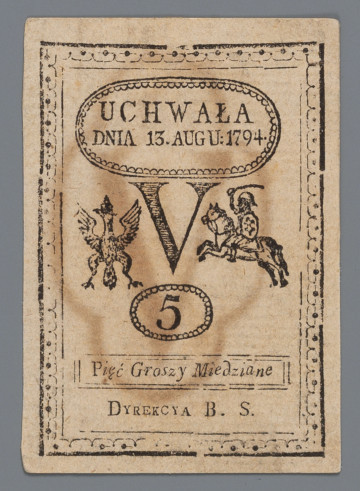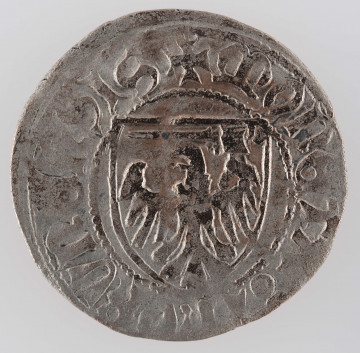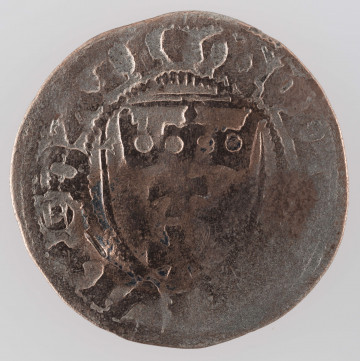
Treasury ticket - 5 copper groshes [Polish: grosze]
1794
National Museum in Lublin
Part of the collection: Money on Polish territory in the Middle Ages
The beginnings of the penny (grosz) are connected to the development of the monetary economy in medieval Europe. At the end of the 12th century in Italy, the need arose to introduce a coin that would be useful in transactions involving large sums of money. That is how coins called thick denarii appeared in Genoa and later in Florence. The Latin name denarius grossus gave rise to the commonly used name grosz. The new type of coinage also spread to other parts of Europe before appearing in Bohemia in 1300. The first Czech ruler to start issuing pennies was King Wenceslas II. He used the help of Florentine minters. In this way, the monetary system based on denars and bracteates was abandoned in Bohemia. These were replaced by the Prague penny and a perfunctory coin constituting one twelfth of the value of a penny, called the small Prague money (parvus Pragensis). From the time of John of Luxembourg, the Czech monetary system was expanded by the first gold coin, the Czech florin. The Prague penny was produced from 1300 to 1547 in an unchanged design. On the obverse in the centre there was an image of a crown surrounded by a double edge inscription containing the name of the ruler and the title of the King of Bohemia, on the reverse in the central field there was a Bohemian lion with a crown on its head and an inscription GROSSI PRAGENSES on the edge. Contrary to the inscription on the rim, most coins were struck not in Prague, but in Kutná Hora, where significant deposits of silver ore were discovered at the end of the 13th century. The Prague pennies gained popularity not only in Bohemia. With the coronation of Wenceslas II as King of Poland, they also found their way to our lands, later also to Lithuania. Despite gradual devaluation resulting from limited silver content, for over two hundred years the Prague penny was the most important circulating coin in Central Europe. In Poland they were imitated by Casimir the Great in the form of the Kraków grosz. Due to the lack of domestic raw material only a small number of these coins were minted and they did not compete with the Prague penny.
The presented coin is slightly larger and heavier than the average Prague penny minted during the reign of John of Luxembourg. Unfortunately, it is impossible to determine in which year or even period of the reign it was produced.
Leszek Poniewozik
Author / creator
Dimensions
cały obiekt: diameter: 28,4 mm
Object type
numismatic
Technique
stamp minting
Material
silver
Creation time / dating
Creation / finding place
Owner
The National Museum in Lublin
Identification number
Location / status

1794
National Museum in Lublin

1457 — 1492
National Museum in Lublin

1457 — 1492
National Museum in Lublin
DISCOVER this TOPIC
National Museum in Szczecin
DISCOVER this PATH
Educational path